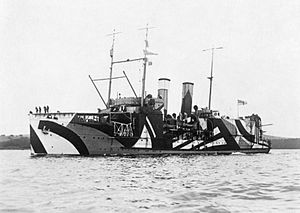 HMS Pegasus in dazzle camouflage
| |
| History | |
|---|---|
| Name | HMS Pegasus |
| Namesake | Pegasus |
| Builder | John Brown & Company, Clydebank |
| Yard number | 431 |
| Laid down | 1914 |
| Launched | 9 June 1917 |
| Completed | 28 August 1917 |
| Acquired | 27 February 1917 |
| Commissioned | 14 August 1917 |
| Fate | Sold for scrap, 22 August 1931 |
| General characteristics | |
| Type | Aircraft/Seaplane carrier |
| Displacement | 3,315 long tons (3,368 t) |
| Length | 332 ft 4 in (101.3 m) |
| Beam | 43 ft (13.1 m) |
| Draught | 15 ft 9 in (4.8 m) |
| Installed power | 9,500 shp (7,100 kW) |
| Propulsion | 2 × shafts, 2 × Steam turbines |
| Speed | 20 kn (37 km/h; 23 mph) |
| Range | 1,220 nmi (2,260 km; 1,400 mi) at 20 kn (37 km/h; 23 mph) |
| Complement | 258 |
| Armament | 4 × 3-inch (76 mm) 12 cwt guns |
| Aircraft carried | 9 |
| Aviation facilities | 1 × flying-off deck forward |
HMS Pegasus was an aircraft carrier/seaplane carrier bought by the Royal Navy in 1917 during the First World War. She was laid down in 1914 by John Brown & Company of Clydebank, Scotland as Stockholm for the Great Eastern Railway Company, but construction was suspended at the start of the war. The ship was converted to operate a mix of wheeled aircraft from her forward flying-off deck and floatplanes that were lowered into the water. Pegasus spent the last year of the war supporting the Grand Fleet in the North Sea, but saw no combat. She spent most of 1919 and 1920 supporting British intervention against the Bolsheviks in North Russia and the Black Sea. The ship remained with the Mediterranean Fleet until 1924, but was placed in reserve in 1925 after a brief deployment to Singapore. Pegasus was sold for scrap in 1931.